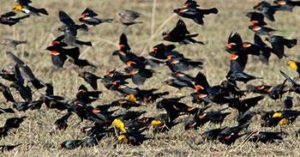A River of Birds Stream by at Night

Most songbirds migrate after dark but red-winged and yellow-headed blackbirds (with brown-headed cowbirds) fly during the day.
Photo credit: Jim Williams
by Val Cunningham
Contributing Writer
Songbirds and shorebirds, geese and ducks and raptors spent the summer raising their young, but now it’s time to head for warmer zones, where food is more abundant.
It’s just plain hard to sleep on autumn nights if I start thinking about one of the most awe-inspiring events in the natural world, the annual passage of billions of birds on their way south.
Most songbirds travel at night, when it’s cooler and fewer predators are on the wing. Hundreds, even thousands of these birds pass in the darkness over my house and neighborhood each evening as they begin their journeys to winter homes. Mixed flocks might include Baltimore orioles, rose-breasted grosbeaks, gray catbirds, tiny warblers and the whole family of thrushes.
Something like 204 of the bird species that breed in Minnesota migrate away each fall. Some, like the blackbird family, travel in daylight. But on some nights, there truly is a river of birds overhead, although their numbers ebb and flow over the migration season. Streams of birds heading south converge from the north, west and east. And this river of birds then stays on course on the journey’s first leg by following a key landmark, the Mississippi River, a major migratory flyway.
Self-guided tour
Many of us assume that birds travel on autopilot, following directional instructions imbedded in their genes, but we now know that birds use a variety of signals to create a migration map.
Navigation over long distances is a complex business: birds assess light patterns from the setting sun and a reading of the local magnetic field as they start out each evening. Along the way, they look up at the stars and down to landmarks on the ground, such as rivers and mountains, to stay on course. Over time, after a number of migrations, they develop a sense for the best route, storing up vital information on good replenishing sites and where to stop to rest. (Young birds do rely for their first trip on instructions hard-wired into their brains, and then modify it as they gain experience.)
Some, like bluebirds, may travel only a few hundred miles. But long-distance champs like purple martins, scarlet tanagers and blackpoll warblers may cover thousands of miles before their final touch down. Some of our summer birds spend the winter among such rainforest exotics as trogons, motmots and manakins.
Running a gauntlet
Migration is the most dangerous and energetically expensive thing birds do in their lives. They fly through storms (even hurricanes), face predators, dodge communications towers and tall buildings, and encounter sites freshly sprayed with pesticides and drastically altered landscapes. Another major hazard is loss of habitat, places to stop and refuel during their flights.
For example, a large stand of bushes whose berries birds feasted on last year may have been plowed under to build a strip mall, and a barrier island that formerly offered shelter might now be covered by a string of vacation homes. These kinds of stopover sites are disappearing at an alarming rate, as we humans build on and plow under open spaces and alter the environment through global warming.
Migration and other hazards add up to a high mortality rate for birds. In fact, fewer than 30 percent of young songbirds survive their first year of life.
Eat and run
If migration is so dangerous, why did birds evolve this way? Why don’t they just spend the entire year in Louisiana, or Mexico?
It’s really all about food. The birds we call neotropical migrants used to be year-round residents of the tropics. But after northern glaciers receded some 10,000 years ago, songbirds began moving north in the spring to take advantage of our wide-open spaces and insect “bloom,” the huge insect hatches typical of our springs and summers. Since nearly all songbirds raise their broods on this high-protein food source, it’s to their advantage to travel hundreds or thousands of miles for abundant food. They race northward, claim nesting territories, stuff their nestlings with insects, watch them fledge, then head south again.
A pair of songbirds feeds their nestlings up to 9,000 caterpillars in the space of just two weeks, before they fledge. These birds and others take advantage of the fact that insects are protein-rich, more so, it turns out, than beef.
So the daunting risks of migration are offset by many advantages, especially the availability of food, with the result that migratory birds produce more offspring, on average, than sedentary tropical songbirds.
You may not see them in the darkness, but summer’s birds are overhead, moving toward their destinations on steady wing beats. It’s worth a little loss of sleep to acknowledge these intrepid beings in the night sky.
Ways you can help
Please keep migrants and resident birds in mind while doing fall garden chores:
- Don’t deadhead spent flowers, let them stand to provide seed and concealed insects.
- Eliminate the use of pesticides in your yard and garden. Chemicals not only can harm birds but also kill off an important food source—insects.
- Plant a native tree or shrub to provide food and shelter for the birds.
- Maintain a clean birdbath—migration is a hot and dusty business.
- Set out a sprinkler with a low setting from time to time to enjoy the migrants it attracts.
St. Paul, Minn., resident Val Cunningham, who leads bird hikes for the St. Paul Audubon Society and writes about nature for local, regional and national newspapers and magazines.


